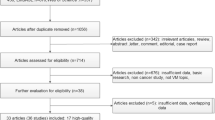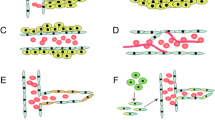Abstract
A previous report has confirmed the existence and clinical significance of vasculogenic mimicry (VM) in glioma. However, its conclusions about the negative clinical significance of VM in glioblastoma are based on a small group of patients and, thus, might be unconvincing. The aim of the present study was to reevaluate the clinical significance of VM in glioblastoma. Patients were classified as VM-positive or VM-negative according to CD34 and periodic acid-Schiff staining. The association between VM and the clinical characteristics of the patients was analyzed. Univariate and multivariate analyses were carried out to identify the independent prognostic factors for overall survival using the Cox regression hazard model. Survival times were estimated using the Kaplan–Meier method and compared using the log-rank test. Of all 86 glioblastomas, 23 were found to have VM. The presence of VM in glioblastoma was not associated with gender, age, Karnofsky performance status, hydrocephalus, tumor burden, microvessel density, tumor relapse, or the extent of tumor resection. The univariate and multivariate analyses revealed that VM is an independent prognostic factor for overall survival. The median survival time for patients with VM was 11.17 months compared with 16.10 months for those without VM (P = 0.017). In addition to VM, an age of 65 years or older, a KPS of 60 or less, a large tumor burden are significant prognostic factors for patient survival. Our data suggest that VM might be an independent adverse prognostic factor in newly diagnosed GBM, further prospective studies are needed to answer this question.


Similar content being viewed by others
References
Sanai N, Alvarez-Buylla A, Berger MS (2005) Neural stem cells and the origin of gliomas. N Engl J Med 353:811–822. doi:10.1056/NEJMra043666
Bleeker FE, Molenaar RJ, Leenstra S (2012) Recent advances in the molecular understanding of glioblastoma. J Neurooncol 108:11–27. doi:10.1007/s11060-011-0793-0
Maniotis AJ, Folberg R, Hess A, Seftor EA, Gardner LM, Pe’er J, Trent JM, Meltzer PS, Hendrix MJ (1999) Vascular channel formation by human melanoma cells in vivo and in vitro: vasculogenic mimicry. Am J Pathol 155:739–752. doi:10.1016/S0002-9440(10)65173-5
Hendrix MJ, Seftor EA, Hess AR, Seftor RE (2003) Vasculogenic mimicry and tumour-cell plasticity: lessons from melanoma. Nat Rev Cancer 3:411–421. doi:10.1038/nrc1092nrc1092
Sood AK, Seftor EA, Fletcher MS, Gardner LM, Heidger PM, Buller RE, Seftor RE, Hendrix MJ (2001) Molecular determinants of ovarian cancer plasticity. Am J Pathol 158:1279–1288. doi:S0002-9440(10)64079-510.1016/S0002-9440(10)64079-5
Kobayashi H, Shirakawa K, Kawamoto S, Saga T, Sato N, Hiraga A, Watanabe I, Heike Y, Togashi K, Konishi J, Brechbiel MW, Wakasugi H (2002) Rapid accumulation and internalization of radiolabeled herceptin in an inflammatory breast cancer xenograft with vasculogenic mimicry predicted by the contrast-enhanced dynamic MRI with the macromolecular contrast agent G6-(1B4M-Gd)(256). Cancer Res 62:860–866
Sharma N, Seftor RE, Seftor EA, Gruman LM, Heidger PM Jr, Cohen MB, Lubaroff DM, Hendrix MJ (2002) Prostatic tumor cell plasticity involves cooperative interactions of distinct phenotypic subpopulations: role in vasculogenic mimicry. Prostate 50:189–201. doi:10.1002/pros.10048
Shirakawa K, Wakasugi H, Heike Y, Watanabe I, Yamada S, Saito K, Konishi F (2002) Vasculogenic mimicry and pseudo-comedo formation in breast cancer. Int J Cancer 99:821–828. doi:10.1002/ijc.10423
Folberg R, Maniotis AJ (2004) Vasculogenic mimicry. APMIS 112:508–525. doi:10.1111/j.1600-0463.2004.apm11207-0810.x
van der Schaft DW, Hillen F, Pauwels P, Kirschmann DA, Castermans K, Egbrink MG, Tran MG, Sciot R, Hauben E, Hogendoorn PC, Delattre O, Maxwell PH, Hendrix MJ, Griffioen AW (2005) Tumor cell plasticity in Ewing sarcoma, an alternative circulatory system stimulated by hypoxia. Cancer Res 65:11520–11528. doi:10.1158/0008-5472.CAN-05-2468
Sood AK, Fletcher MS, Zahn CM, Gruman LM, Coffin JE, Seftor EA, Hendrix MJ (2002) The clinical significance of tumor cell-lined vasculature in ovarian carcinoma: implications for anti-vasculogenic therapy. Cancer Biol Ther 1:661–664. doi:316
Sun B, Zhang S, Zhao X, Zhang W, Hao X (2004) Vasculogenic mimicry is associated with poor survival in patients with mesothelial sarcomas and alveolar rhabdomyosarcomas. Int J Oncol 25:1609–1614
Sun B, Qie S, Zhang S, Sun T, Zhao X, Gao S, Ni C, Wang X, Liu Y, Zhang L (2008) Role and mechanism of vasculogenic mimicry in gastrointestinal stromal tumors. Hum Pathol 39:444–451. doi:10.1016/j.humpath.2007.07.018
Vartanian AA, Stepanova EV, Gutorov SL, Solomko E, Grigorieva IN, Sokolova IN, Baryshnikov AY, Lichinitser MR (2009) Prognostic significance of periodic acid-Schiff-positive patterns in clear cell renal cell carcinoma. Can J Urol 16:4726–4732
Wang SY, Yu L, Ling GQ, Xiao S, Sun XL, Song ZH, Liu YJ, Jiang XD, Cai YQ, Ke YQ (2012) Vasculogenic mimicry and its clinical significance in medulloblastoma. Cancer Biol Ther 13:341–348. doi:1910810.4161/cbt.19108
Liu XM, Zhang QP, Mu YG, Zhang XH, Sai K, Pang JC, Ng HK, Chen ZP (2011) Clinical significance of vasculogenic mimicry in human gliomas. J Neurooncol 105:173–179. doi:10.1007/s11060-011-0578-5
Louis DN, Ohgaki H, Wiestler OD, Cavenee WK, Burger PC, Jouvet A, Scheithauer BW, Kleihues P (2007) The 2007 WHO classification of tumours of the central nervous system. Acta Neuropathol 114:97–109. doi:10.1007/s00401-007-0243-4
Carmeliet P, Jain RK (2011) Molecular mechanisms and clinical applications of angiogenesis. Nature 473:298–307. doi:10.1038/nature10144
Dome B, Hendrix MJ, Paku S, Tovari J, Timar J (2007) Alternative vascularization mechanisms in cancer: pathology and therapeutic implications. Am J Pathol 170:1–15. doi:10.2353/ajpath.2007.060302
Wang R, Chadalavada K, Wilshire J, Kowalik U, Hovinga KE, Geber A, Fligelman B, Leversha M, Brennan C, Tabar V (2010) Glioblastoma stem-like cells give rise to tumour endothelium. Nature 468:829–833. doi:10.1038/nature09624
Ricci-Vitiani L, Pallini R, Biffoni M, Todaro M, Invernici G, Cenci T, Maira G, Parati EA, Stassi G, Larocca LM, De Maria R (2010) Tumour vascularization via endothelial differentiation of glioblastoma stem-like cells. Nature 468:824–828. doi:10.1038/nature09557
Kirschmann DA, Seftor EA, Hardy KM, Seftor RE, Hendrix MJ (2012) Molecular pathways: vasculogenic mimicry in tumor cells: diagnostic and therapeutic implications. Clin Cancer Res 18:2726–2732. doi:10.1158/1078-0432.CCR-11-3237
van der Schaft DW, Seftor RE, Seftor EA, Hess AR, Gruman LM, Kirschmann DA, Yokoyama Y, Griffioen AW, Hendrix MJ (2004) Effects of angiogenesis inhibitors on vascular network formation by human endothelial and melanoma cells. J Natl Cancer Inst 96:1473–1477. doi:10.1093/jnci/djh267
Ogawa K, Pasqualini R, Lindberg RA, Kain R, Freeman AL, Pasquale EB (2000) The ephrin-A1 ligand and its receptor, EphA2, are expressed during tumor neovascularization. Oncogene 19:6043–6052. doi:10.1038/sj.onc.1204004
Hess AR, Seftor EA, Gardner LM, Carles-Kinch K, Schneider GB, Seftor RE, Kinch MS, Hendrix MJ (2001) Molecular regulation of tumor cell vasculogenic mimicry by tyrosine phosphorylation: role of epithelial cell kinase (Eck/EphA2). Cancer Res 61:3250–3255
Sun XL, Xu ZM, Ke YQ, Hu CC, Wang SY, Ling GQ, Yan ZJ, Liu YJ, Song ZH, Jiang XD, Xu RX (2011) Molecular targeting of malignant glioma cells with an EphA2-specific immunotoxin delivered by human bone marrow-derived mesenchymal stem cells. Cancer Lett 312:168–177. doi:10.1016/j.canlet.2011.07.035
Dong J, Zhao Y, Huang Q, Fei X, Diao Y, Shen Y, Xiao H, Zhang T, Lan Q, Gu X (2011) Glioma stem/progenitor cells contribute to neovascularization via transdifferentiation. Stem Cell Rev 7:141–152. doi:10.1007/s12015-010-9169-7
Vordermark D, Ruprecht K, Rieckmann P, Roggendorf W, Vince GH, Warmuth-Metz M, Kolbl O, Flentje M (2006) Glioblastoma multiforme with oligodendroglial component (GBMO): favorable outcome after post-operative radiotherapy and chemotherapy with nimustine (ACNU) and teniposide (VM26). BMC Cancer 6:247. doi:10.1186/1471-2407-6-247
Wang Y, Li S, Chen L, You G, Bao Z, Yan W, Shi Z, Chen Y, Yao K, Zhang W, Kang C, Jiang T (2012) Glioblastoma with an oligodendroglioma component: distinct clinical behavior, genetic alterations, and outcome. Neuro-Oncology 14:518–525. doi:10.1093/neuonc/nor232nor232
Kanno H, Nishihara H, Narita T, Yamaguchi S, Kobayashi H, Tanino M, Kimura T, Terasaka S, Tanaka S (2012) Prognostic implication of histological oligodendroglial tumor component: clinicopathological analysis of 111 cases of malignant gliomas. PLoS ONE 7:e41669. doi:10.1371/journal.pone.0041669
Raysi Dehcordi S, De Paulis D, Marzi S, Ricci A, Cimini A, Cifone MG, Galzio RJ (2012) Survival prognostic factors in patients with glioblastoma: our experience. J Neurosurg Sci 56:239–245. doi:R38122387
Allahdini F, Amirjamshidi A, Reza-Zarei M, Abdollahi M (2010) Evaluating the prognostic factors effective on the outcome of patients with glioblastoma multiformis: does maximal resection of the tumor lengthen the median survival? World Neurosurg 73:128–134. discussion e116 doi:10.1016/j.wneu.2009.06.001
Birlik B, Canda S, Ozer E (2006) Tumour vascularity is of prognostic significance in adult, but not paediatric astrocytomas. Neuropathol Appl Neurobiol 32:532–538. doi:10.1111/j.1365-2990.2006.00763.x
Sanai N, Berger (2008) Glioma extent of resection and its impact on patient outcome. Neurosurgery 62:753–764; discussion 264-756. doi:10.1227/01.neu.0000318159.21731.cf
Hardesty DA, Sanai N (2012) The value of glioma extent of resection in the modern neurosurgical era. Front Neurol 3:140. doi:10.3389/fneur.2012.00140
Metcalfe SE (2000) Biopsy versus resection for malignant glioma. Cochrane Database Syst Rev: CD002034. doi:10.1002/14651858.CD002034
Acknowledgments
We express our gratitude to Professor Shengli An (Department of Biostatistics, Southern Medical University) for the statistical data analyses and Mr. Xuan Lu (Department of Pathology, Zhujiang Hospital, Southern Medical University) for the sectioning of tissues. This project was supported by the National Science Foundation of China (Nos. 30901774 and 81272806) and the Natural Science Foundation of Guangdong Province, China (No. 8151051501000066).
Conflict of interest
The authors disclose that no potential conflicts of interest exist.
Author information
Authors and Affiliations
Corresponding author
Additional information
Shi-yong Wang and Yi-quan Ke contributed equally to this study.
Rights and permissions
About this article
Cite this article
Wang, Sy., Ke, Yq., Lu, Gh. et al. Vasculogenic mimicry is a prognostic factor for postoperative survival in patients with glioblastoma. J Neurooncol 112, 339–345 (2013). https://doi.org/10.1007/s11060-013-1077-7
Received:
Accepted:
Published:
Issue Date:
DOI: https://doi.org/10.1007/s11060-013-1077-7




